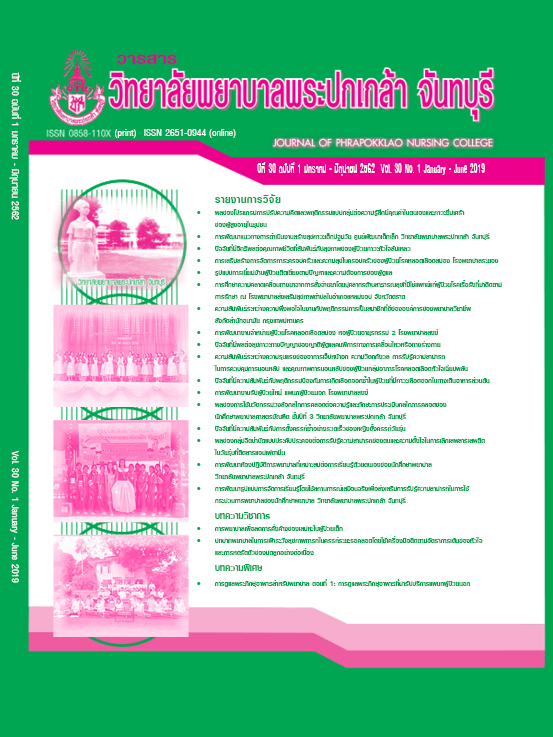The Factors Related to Rapid Repeat Pregnancy among Teenage Pregnant Women
Keywords:
Teenage pregnant women, Rapid repeat pregnancyAbstract
This descriptive correlational research aimed to examine the rapid repeat pregnancy rate and factors related to rapid repeat pregnancy among teenage pregnant women. The samples consisted of 75 teenage pregnant women receiving services at antenatal clinic, Nopparatrajathanee Hospital, Klang Hospital, and Taksin Hospital, Bangkok. The research instrument was a 2-part questionnaire:- personal data, and perceived intensity of repeat pregnancy in teenager with the reliability of .79. Data were collected from April to September, 2016. Statistics used for data analysis included frequency, percentage, mean, standard deviation, Chi-square test, and Fisher’s exact test.
The research results revealed that teenage pregnant women had 62.70% of rapid repeat pregnancy rate. Factors that statistically significant related to rapid repeat pregnancy were the utilization of contraception problems (2 = 4.189, p < .05), marital status (
2 = 3.828, p < .05), and fulfilling need to have children (
2 = 5.506, p < .05).
This research suggests that professional nurses should enhance proper knowledge regarding the effect of rapid repeat pregnancy, an interval of pregnancy, contraception, and side effects of each contraceptive method among teenage pregnant women and their families.
References
กิตติพงศ์ แซ่เจ็ง, บุญฤทธิ์ สุขรัตน์, และประกายดาว พรหมประพัฒน์. (2557). ผลกระทบของการตั้งครรภ์ในวัยรุ่น. ใน กิตติพงศ์ แซ่เจ็ง, บุญฤทธิ์ สุขรัตน์, เอกชัย โควาวิสารัช, ประกายดาว พรหมประพัฒน์, และจันทกานต์ กาญจนเวทางค์ (บ.ก.), คู่มือแนวทางปฏิบัติการดูแลแม่วัยรุ่น (น. 10). กรุงเทพฯ: ศูนย์สื่อและสิ่งพิมพ์แก้วเจ้าจอม.
เกตย์สิรี ศรีวิไล. (2559). การตั้งครรภ์ซ้ำในมารดาวัยรุ่นในโรงพยาบาลชุมชนแห่งหนึ่งของภาคใต้. วารสารเครือข่ายวิทยาลัยพยาบาลและการสาธารณสุขภาคใต้, 3(3), 142-152.
ชลทิศ อุไรฤกษ์กุล. (2553). การตั้งครรภ์ในวัยรุ่น (Teenage pregnancy). สืบค้นจาก http://hpe4.anamai.moph.go.th/hpe/data/mch/teenagePregnancy.pdf
ปฏิญญา เอี่ยมสำอางค์. (2555). ปัจจัยเสี่ยงต่อการตั้งครรภ์ที่ไม่ตั้งใจของวัยรุ่น (วิทยานิพนธ์ปริญญามหาบัณฑิต). ชลบุรี: มหาวิทยาลัยบูรพา.
ปัญญา สนั่นพานิชกุล, และยศพล เหลืองโสมนภา. (2558). การตั้งครรภ์ในวัยรุ่น: ปัจจัยทางด้านมารดาที่มีผลต่อทารก. วารสารศูนย์การศึกษาแพทยศาสตร์คลินิก โรงพยาบาลพระปกเกล้า, 32(2), 156-174.
ปิยะรัตน์ เอี่ยมคง, และอารีรัตน์ จันทร์ลำภู. (บ.ก.). (2557). สถิติการคลอดของแม่วัยรุ่น ประเทศไทย ปี พ.ศ. 2556. กรุงเทพฯ: สำนักงานกิจการโรงพิมพ์ องค์การสงเคราะห์ทหารผ่านศึก ในพระบรมราชูปถัมภ์.
มนสิการ กาญจนะจิตรา. (2557). สถานการณ์ “แม่วัยใส” รอบโลก. สืบค้นจาก http://www2.ipsr.mahidol.ac.th
ฤดี ปุงบางกะดี่, และเอมพร รตินธร. (2557). ปัจจัยและผลกระทบจากการตั้งครรภ์ซ้ำของสตรีวัยรุ่นไทย: กรณีศึกษาในกรุงเทพมหานคร. Journal of Nursing Science, 32(2), 23-31. สืบค้นจาก http://www.ns.mahidol.ac.th/english/journal_NS/pdf/vol32/issue2/rudee.pdf
แววดาว พิมลธเรศ. (2555). อุบัติการณ์การตั้งครรภ์และภาวะแทรกซ้อนของหญิงตั้งครรภ์วัยรุ่นในโรงพยาบาลหนองใหญ่ จังหวัดชลบุรี. วารสารศูนย์การศึกษาแพทยศาสตร์คลินิก โรงพยาบาลพระปกเกล้า, 29(4), 301-311.
สำนักงานคณะกรรมการพัฒนาการเศรษฐกิจและสังคมแห่งชาติ. (2556). สถานการณ์การตั้งครรภ์ในวันรุ่นในประเทศไทย ปี 2556. สืบค้นจาก https://www.m-society.go.th/article_attach/11829/16120.pdf
สํานักงานปลัดกระทรวงการพัฒนาสังคมและความมั่นคงของมนุษย์. (2557). สถานการณ์การคลอดบุตรของวันรุ่นไทย ปี 2556. สืบค้นจาก http://dcy.go.th/webnew/uploadchild/cld/download/file_th_20152002002459_1.pdf
สำนักอนามัยการเจริญพันธุ์ กระทรวงสาธารณสุข. (2555). การตั้งครรภ์ในวัยรุ่น: นโยบาย แนวทางการดำเนินงาน และติดตามประเมินผล. สืบค้นจาก http://www.dmh.go.th
สุนารี เลิศทำนองธรรม. (2546). เหตุผลทางสังคม วัฒนธรรมในการตัดสินใจทำแท้งจากการตั้งครรภ์ไม่พึงประสงค์ของหญิงวัยรุ่น (วิทยานิพนธ์ปริญญามหาบัณฑิต). มหาวิทยาลัยเชียงใหม่.
สุนีย์ จุ่มกลาง. (2559). ปัจจัยที่มีความสัมพันธ์กับการใช้ยาฝังคุมกำเนิดโดยใช้แนวคิดการให้ข้อมูลข่าวสาร แรงจูงใจ และทักษะพฤติกรรมในมารดาวัยรุ่น (วิทยานิพนธ์ปริญญามหาบัณฑิต). ชลบุรี: มหาวิทยาลัยบูรพา.
อังสนา วิศรุตเกษมพงศ์. (2557). ปัจจัยที่มีความสัมพันธ์กับความตั้งใจตั้งครรภ์ซ้ำในหญิงตั้งครรภ์วัยรุ่น (วิทยานิพนธ์ปริญญามหาบัณฑิต). มหาวิทยาลัยขอนแก่น.
Baldwin, M. K., & Edelman, A. B. (2013). The effect of long-acting reversible contraception on rapid repeat pregnancy in adolescents: A review. Journal of Adolescent Health, 52(4 Suppl.), S47-S53.
Boardman, L. A., Allsworth, J., Phipps, M. G., & Lapane, K. L. (2006). Risk factors for unintended versus intended rapid repeat pregnancies among adolescents. Journal of Adolescent Health, 39(4), 597-600.
Cochran, W. G. (1953). Sampling techniques. New York: John Wiley & Sons.
Crittenden, C. P., Boris, N. W., Rice, J. C., Taylor, C. A., & Olds, D. L. (2009). The role of mental health factors, behavioral factors, and past experiences in the prediction of rapid repeat pregnancy in adolescence. Journal of Adolescent Health, 44(1), 25-32.
El-Kamary, S. S., Higman, S. M., Fuddy, L., McFarlane, E., Sia, C., & Duggan, A. K. (2004). Hawaii’s healthy start home visiting program: Determinants and impact of rapid repeat birth. Pediatrics, 114(3), e317-e326.
Lewis, L. N., Doherty, D. A., Hickey, M., & Skinner, S. R. (2010). Predictors of sexual intercourse and rapid-repeat pregnancy among teenage mothers: An Australian prospective longitudinal study. The Medical Journal of Australia, 193(6), 338-342.
McLeroy, K. R., Bibeau, D., Steckler, A., & Glanz, K. (1988). An ecological perspective on health promotion programs. Health Education Quarterly, 15(4), 351-377.
Omar, H. A., Fowler, A., & McClanahan, K. K. (2008). Significant reduction of repeat teen pregnancy in a comprehensive young parent program. Journal of Pediatric and Adolescent Gynecology, 21(5), 283-287.
Padin, M. D. F. R., Silva, R. D. S. E., Mitsuhiro, S. S., Chalem, E., Barros, M. M., Guinsburg, R., & Laranjeira, R. (2012). Repeat pregnancies among adolescents in a tertiary hospital in Brazil. Journal of Reproductive and Infant Psychology, 30(2), 193-200.
Rosengard, C. (2009). Confronting the intendedness of adolescent rapid repeat pregnancy. Journal of Adolescent Health, 44(1), 5-6.
Rowlands, S. (2010). Social predictors of repeat adolescent pregnancy and focussed strategies. Best Practice & Research. Clinical Obstetrics & Gynaecology, 24(5), 605-616.
Timur, H., Kokanalı, M. K., Topçu, H. O., Topçu, S., Erkılınç, S., Uygur, D., & Yakut, H. I. (2016). Factors that affect perinatal outcomes of the second pregnancy of adolescents. Journal of Pediatric and Adolescent Gynecology, 29(1), 18-21.
Downloads
Published
How to Cite
Issue
Section
License
Copyright (c) 2019 JOURNAL OF PHRAPOKKLAO NURSING COLLEGE

This work is licensed under a Creative Commons Attribution-NonCommercial-NoDerivatives 4.0 International License.
เนื้อความ ข้อมูล และรายการอ้างอิงที่ผู้เขียนใช้ในการเขียนบทความเพื่อลงตีพิมพ์ในวารสารวิทยาลัยพยาบาลพระปกเกล้า จันทบุรี ถือเป็นความคิดเห็นและความรับผิดชอบของผู้เขียน คณะผู้จัดทำวารสารไม่จำเป็นต้องเห็นพ้องด้วยหรือร่วมรับผิดชอบ
บทความที่ได้รับการลงตีพิมพ์ในวารสารวิทยาลัยพยาบาลพระปกเกล้า จันทบุรี ถือเป็นลิขสิทธิ์ของวารสารวิทยาลัยพยาบาลพระปกเกล้า จันทบุรี หากหน่วยงานหรือบุคคลใดต้องการนำส่วนหนึ่งหรือทั้งหมดของบทความไปเผยแพร่ต่อเพื่อวัตถุประสงค์ใด ๆ จะต้องได้รับอนุญาตจากบรรณาธิการวารสารก่อน



